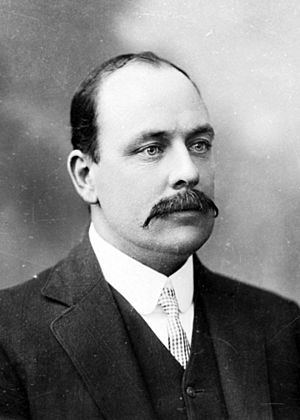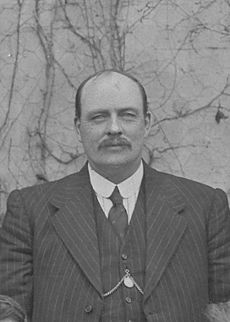John Scaddan facts for kids
Quick facts for kids
John Scaddan
|
|
|---|---|
 |
|
| 10th Premier of Western Australia | |
| In office 7 October 1911 – 27 July 1916 |
|
| Monarch | George V |
| Governor | Sir Gerald Strickland Sir Harry Barron |
| Preceded by | Frank Wilson |
| Succeeded by | Frank Wilson |
| Personal details | |
| Born | 4 August 1876 Moonta, South Australia, Australia |
| Died | 21 November 1934 (aged 58) Perth, Western Australia, Australia |
| Nationality | British subject |
| Political party | Labor (1904–1917) National Labor (1917) Nationalist (c. 1917–1920, 1930–1934) Country (1920–1924) |
| Spouses | Elizabeth Fawkner; Henrietta Edwards |
| Profession | Engine driver |
John Scaddan, also known as "Happy Jack", was an important political leader in Western Australia. He served as the Premier of Western Australia (like a state prime minister) from 1911 to 1916. He was also a member of the Order of St Michael and St George (CMG), an honour given for public service.
Contents
Early Life and Work
John Scaddan was born in Moonta, South Australia, on August 4, 1876. His family had Cornish roots. He went to state schools in Woodside and Eaglehawk, Victoria.
When he was just 13, John started working in mines in Eaglehawk. He also continued his education part-time at the Bendigo School of Mines and Industries. In 1896, he moved to Western Australia, likely joining the gold rush in the Kalgoorlie area. He first worked as a miner underground. Later, he became an engine driver, operating large machines at the mine.
In 1900, John married Elizabeth Fauckner in Boulder. Sadly, she passed away in 1902. In 1904, he married Henrietta Edwards.
Starting in Politics
John Scaddan was very interested in workers' rights and economic issues. He became a strong supporter of unions, which are groups that protect workers' interests.
In 1904, he decided to enter politics. He ran for the Western Australian Legislative Assembly (the state parliament) in the area called Ivanhoe. He won the seat easily for the Labor Party.
Even though he won, he wasn't asked to be a minister in the government at that time. This actually helped him later. Other politicians who were part of that government faced problems, but John Scaddan did not.
Becoming a Leader
John Scaddan was re-elected without anyone running against him in 1905. For the next four years, he worked as the Labor Party's secretary. In 1910, the party leader, Thomas Bath, retired. John Scaddan then became the new leader of the Labor Party. This also made him the Leader of the Opposition, meaning he led the main party not in power.
In the 1911 election, the Labor Party had many new and bold ideas for Western Australia. John Scaddan easily won his seat, which was now called Brown Hill-Ivanhoe. The Labor Party won a huge number of seats. On October 7, 1911, John Scaddan became the Premier of Western Australia. He was only 35 years old, making him the youngest premier the state has ever had!
Premier of Western Australia
As Premier, John Scaddan led a very active government that brought in many changes.
In 1911, his government passed the Workers' Homes Act. This law made it easier for people with lower incomes to buy their own homes. In 1912, they also made the Arbitration Court more powerful. This court helps settle disagreements between workers and employers. They also improved Workers' compensation, which provides support for workers injured on the job.
The government spent a lot of money developing the Wheatbelt region. They built more railways to help farmers transport their crops. Farmers settling in the eastern wheat belt received help with loans, expert advice, and new railways. This led to a big increase in farming production.
Scaddan's government also introduced an income tax in 1912 to help pay for these changes. This tax was increased even more after World War I started. The government also borrowed a lot of money.
State-Owned Businesses
One of the most remembered things about Scaddan's government was its idea of setting up state-owned businesses. He called this "state socialism," but it was more about the government owning and running businesses to help the public.
His government got involved in many different industries:
- They started a state shipping service.
- They opened a dairy farm and a sawmill.
- They reopened a quarry (where stone is dug up).
- They set up a brickworks and a factory for agricultural tools.
- They took over the South Perth ferries and Perth's trams.
- They started abattoirs (places where animals are processed for meat).
- They even bought hotels!
Challenges and Defeat
Scaddan's government faced many challenges. The Western Australian Legislative Council (the upper house of parliament) often tried to block his new laws. His government won only a third of its votes in the Legislative Council.
In the 1914 election, Scaddan's government was re-elected, but with a very small majority. This made it harder to pass laws. Then, World War I started in 1914, and Western Australia faced one of its worst droughts. These events made things even more difficult.
The government's position became weaker when some members of parliament left or voted against the Labor Party. In July 1916, other political parties worked together to defeat Scaddan's government. John Scaddan asked the Governor to hold a new election, but the Governor said no. So, John Scaddan resigned as Premier on July 27, 1916. Frank Wilson then became the new Premier.
After Being Premier
After losing his role as Premier, John Scaddan remained the Labor Party leader. He tried to win a different seat in parliament but lost. However, he was re-elected to his old seat of Brown Hill-Ivanhoe in October 1916.
Changing Political Parties
Around 1916, the federal Labor Party split over the issue of conscription (forcing people to join the army). John Scaddan supported conscription, which put him at odds with his own party. In April 1917, he resigned from the Australian Labor Party.
He then joined the Nationalist Party. In June 1917, he became a minister in the new Nationalist government, looking after Mines and Railways. He continued to hold various ministerial roles in different governments until 1924. In 1923, he was awarded the Companion of the Order of St Michael and St George (CMG) for his service.
John Scaddan did not run in the 1924 election. He tried to get back into parliament in 1927 but was unsuccessful. In 1930, he won the seat of Maylands and again became a minister, responsible for Railways, Mines, Police, Forests, and Industry. However, in the 1933 election, he lost his seat, and his government was defeated.
Later Life
From 1927 onwards, John Scaddan worked as an agent for stocks, farms, and estates. He was also a member of the Perth Roads Board from 1926 and its chairman from 1931 to 1934. He passed away suddenly on November 21, 1934, and was buried at Karrakatta Cemetery.
Locality Names
The town of Scaddan in the Goldfields-Esperance region of Western Australia is named after John Scaddan.


